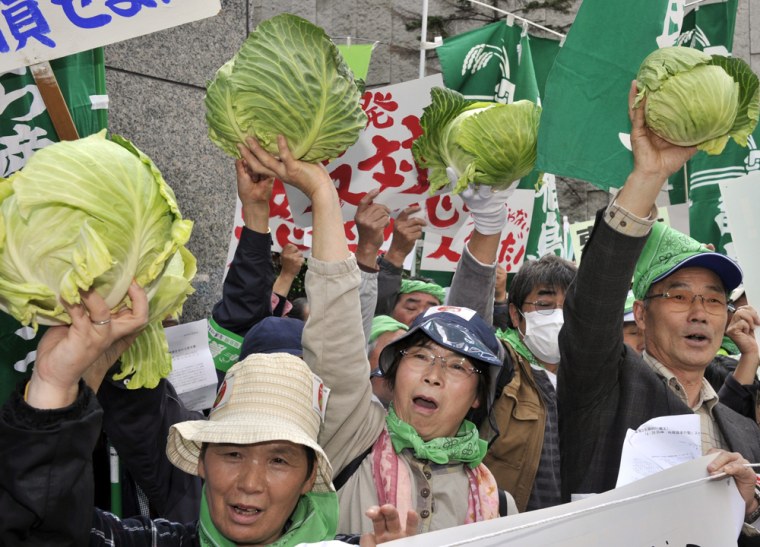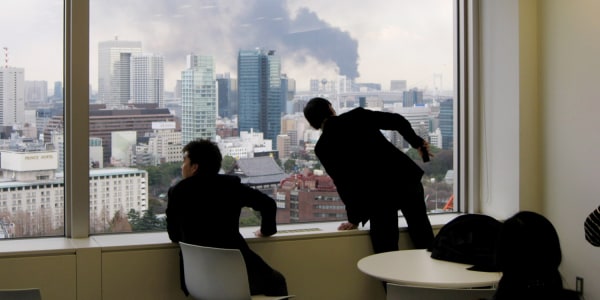Angry farmers brought two cows to Tokyo where they shouted and punched the air Tuesday in a protest to demand compensation for products contaminated by radiation spewing from Japan's crippled nuclear plant.
The 200 farmers from northeastern Japan wore green bandanas, held aloft cabbages they said they couldn't sell and carried signs saying "Stop nuclear energy" outside the headquarters of Tokyo Electric Power Co., the operator of the plant damaged in the March 11 tsunami.
"My patience has run out. The nuclear crisis is totally destroying our farming business," said 72-year-old Katsuo Okazaki, who grows peaches and apples.
Radiation leaking from Fukushima Dai-ichi plant — about 140 miles north of Tokyo — has been found in milk, water and vegetables such as spinach from around the plant.
Authorities have banned the sale of raw milk from some towns near the plant, as well as spinach, cabbage, broccoli and several other leafy vegetables from throughout Fukushima prefecture, though most restrictions in nearby prefectures have been lifted.
Slideshow 46 photos
Triple tragedy for Japan
But even once restrictions are removed and produce is deemed safe, farmers throughout the northeast fear consumers will shun their products.
The utility says it will take six to nine months to bring the plant into cold shutdown, a crucial step for allowing the roughly 80,000 people evacuated from a 12-mile area around the plant to return home.
Animals dying
Farmers among the evacuees also are concerned about the estimated 3,000 cows, 130,000 pigs and 680,000 chickens they had to leave behind to fend for themselves. Some have died already, and many are weak and dying.
"I'm here in protest, and to get an apology," said Masaki Yoshizawa, who had 300 head of high-grade "wagyu" cattle on a ranch about 9 miles from the plant.
TEPCO will start depositing initial compensation payments of 1 million yen ($12,000) per household on Tuesday into bank accounts of people forced to evacuate due to leaking radiation, Trade Minister Banri Kaieda said.
Okazaki, the fruit farmer, isn't eligible because his farm is 37 miles from the plant, but he still wants compensation, fearing a lengthy slump in demand for farm products from his region. He said vegetable growers already had lost a great deal of money.
"I am constantly worried about this, and feel like my strength is being sapped away," he said.
Farmers, who brought the cows to highlight the milk sale bans, took turns shouting their frustrations into a microphone, their words carried over a loudspeaker mounted atop a van, as lunch-hour passers-by in the busy office district stopped and gawked at the animals in the back of a truck.
"We have no dreams. No hope. Each day, I ask myself 'how do I live?" shouted Kazuhiko Suzuki, 70, from Fukushima.
"TEPCO, give us back our cows and pigs and chickens," yelled another farmer.
Salaries cut
With its liability likely to stretch into the billions, TEPCO announced Monday it would slash executive compensation by 50 percent, cut managers' salaries by 25 percent and low-level employees would get a 20 percent pay cut.
It also planned to freeze hiring for next year. The amount saved would total 54 billion yen ($660 million) for the year, the company said.
Meanwhile, Fukushima authorities sent six veterinarians Tuesday into the 12-mile evacuation zone around the nuclear plant to survey livestock there.
With no time for burials, veterinarians will spray lime over any dead animals to prevent them from spreading disease, agricultural officials said.
Dying or weakened animals will be euthanized only after getting the owners' permission, but that could prove difficult, because they are scattered in evacuation centers.
In another setback at the nuclear plant, workers detected water leaking from the containment vessel of Unit 1, and will send robots into the reactor to investigate, said Hidehiko Nishiyama, a spokesman for the Nuclear and Industrial Safety Agency.
He couldn't give details on the amount of the leak or where it was accumulating.
The development casts doubt over an emerging plan to fill water into the containment vessel, a huge chamber also called the dry well that's shaped like an upside-down light bulb and surrounds the reactor core.
Some water already has accumulated there after being pumped into the reactor core to cool fuel rods.
Engineers are considering whether to fill the dry well with water to further cool the core, but must assess whether the vessel would remain structurally sound or become vulnerable to additional earthquakes.
"We must check the quake resistance of the reactor," Nishiyama said.
Marking the 25th anniversary of the Chernobyl nuclear accident, a group of 87 Japanese anti-nuclear groups issued a joint statement criticizing TEPCO's failure to prepare adequately for a large tsunami as "immoral and criminal."
Warnings about "the danger of a huge earthquake and tsunami ... were not taken seriously," said the statement released by the Citizens' Nuclear Information Center.

